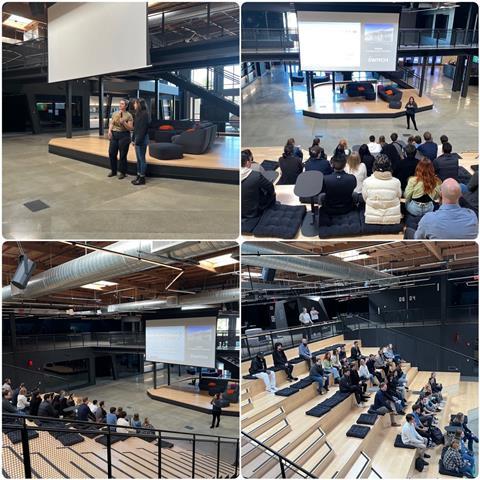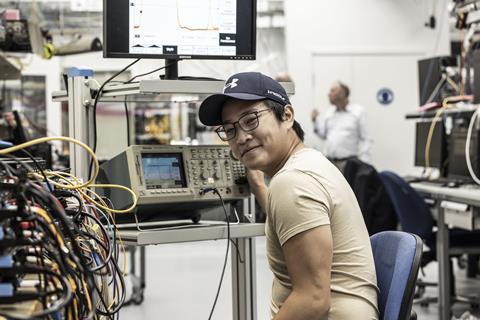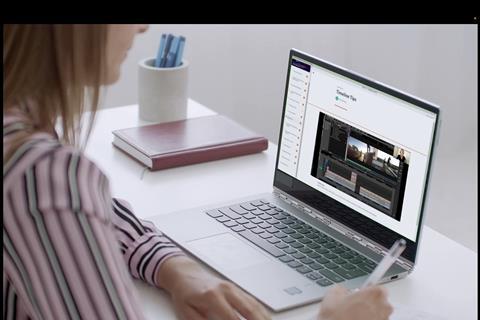As a long-term pacesetter for the use of new broadcast technology, it’s to be expected that the industry-wide skills gap is especially acute in live sports, writes David Davies.
From HD to 4K, HDR and IP-based production, live sports has always been a critical testing ground for new technologies. With broadcasters and rights holders eager to enhance their offerings in a hugely competitive sector, there is an availability of resources that allows emerging technologies to be fully assessed – sometimes when they are still at a relatively formative stage.

Of course, all of that depends on having the skills and talent to develop and deploy new technologies successfully. The ascension to prominence in recent years of initiatives such as the RISE Academy, ScreenSkills and the Global Media and Entertainment Talent Manifesto is part of a broader recognition of the need to take a more active role in nurturing new generations of engineering and technical talent if the industry is to continue thriving.
Read more Streaming rights: live sports unite audiences in cultural moments worth fighting for
Several generational and societal shifts – by no means limited to M&E – are contributing to the current skills challenges, but the impact of the last decade’s relentless technological change should also not be underestimated.
Perfect storm
Kevin Salvidge, Sales Engineering & Technical Marketing Manager at test and measurement solutions developer Leader Electronics of Europe, is not alone in indicating that the advent of new formats and workflows has served to pinpoint the areas where an increasingly diverse range of skills is required.

“We’ve seen a worldwide skills shortage across all production genres in the broadcast industry, especially live sports production,” confirms Salvidge, who implies that a perfect storm of changes has been a critical factor. “We’ve seen technology advancing at a rapid rate with the growth of 4K, HDR, and the deployment of IP infrastructures. For example, HDR was initially used for major tier-one live productions, but the demands of broadcasters to also deliver SDR has resulted in complex workflows. [It may also be the case that] only the HDR supervisors will have visibility of the HDR programming in a broadcast truck, which is restricting the distribution of HDR knowledge.”
He suggests that “the understanding of the principles of HDR” is more advanced in on-set production and post, meaning that “in some ways, we need the democratisation of technology to filter down – but then also we need access to the skills when that does happen.” In the meantime, production companies won’t need any encouragement to hire young engineers “who understand HDR, SDI, IP, and how programmes are made… That hybrid kind of person is very rare on the ground.”

Paul Evans, Solution Area Expert IP Gateway at media delivery innovator Net Insight, also highlights the migration towards IP networks and a resulting “emphasis on general networking, design and security. These skills are available in the IT and networking industry, but [personnel from those sectors may] lack the broadcast-specific skills required to work with media signals. Finding the right mix of these skills has been challenging in recent times, although people are adapting.”
Skills transference and sports tiers
Glenn Adamo, Head of Production Services at live video production and transmission specialists Tata Communications/The Switch, has a more positive take on the latter-day transferability of skills. “The next generation of media-casters are going to be in a really good place because they are a lot more computer literate than people were 20 years ago. They embrace new technology and that allows them to develop the other necessary skills that are needed to become an accomplished pro, so to speak.”

In addition to having the core IT skills in place, he also thinks that increased content production at universities, across different courses and disciplines, is serving students well. “Taking a more active role in hosting their own websites, creating their own content, and covering their own events has allowed students to [effectively] be in the business from the time they’re in college,” he says. “Which means that when some students graduate with four years of experience, they’re able to quickly step up.”
Read more The Future of Broadcast Engineering: Navigating the Cloud Computing Revolution
Adamo also suggests that the democratisation of broadcast-quality software, in particular, has contributed to incoming talent possessing a broader range of production skills. “It used to be the case that there would be someone who got to be exalted as a great editor [for a particular type of show] and you would want to get him because he would make shows look great, but in reality, his skill-set was kind of narrow.” A similar specialism in graphics was also common, but the advent of accessible online tools has meant that people are much more likely to “not only have the skills to edit or do graphics, and so on.”
But whilst the capacity of individual staff to adapt may be greater now, it doesn’t necessarily follow that entire organisations – especially when they are engaged in producing something as complex and costly as live sports – have the bandwidth to do the same.
Evans explains: “Sports is one of the most lucrative forms of content, but within that industry, there are different tiers – from the Premier League to grassroots. Often, the largest broadcasters have these resources, but smaller companies might struggle.”
These challenges are likely to be further amplified by the move to the cloud. “The adoption of cloud-based broadcasting has created an additional layer of complexity, requiring expertise in both cloud infrastructure and traditional broadcast technology. This dual requirement has increased skills shortages – especially in smaller companies that may not have the resources to invest in comprehensive training programmes,” says Evans.
Fulfilling career paths
However, there has been a decisive trend of late among the leading vendors in this space to expand their online and in-person training. Avid is a prime example and recently announced a new collaboration with educational platform Post Super to deliver co-branded courses and micro-certifications – drawing upon “real-world experiences and best practices”.

Jason Plews, VP Learning Services at Avid, indicates that skills shortages are becoming increasingly multi-faceted. “We’re seeing skills gaps at the entry-level, which puts pressure on facilities having to train and ramp up new staff on workflows and technology before they can become productive,” he says. “Avid’s Learning Partner programme aims to address these gaps – with our Pro Tools and Media Composer courses and certifications, and now the Post Super post-production courses and certifications – to prepare the next generation for [these careers].”

Simultaneously, adds Plews: “We’re also seeing shortages in technical skills with many seasoned engineers due to retire in the coming years. This needs to be addressed by attracting more technology and IT-focused students into the media industry, and educating media students that there is also a very rewarding and fulfilling career path on the technical side of the industry.”
Broader generational shifts that mean Gen X – and, to an even greater degree, members of Gen Y – are more inclined to spend shorter periods at a larger number of employers. The notion of a young engineer joining a broadcaster like the BBC or NBC at age 21 and remaining there until retirement – once a common reality – now seems largely consigned to the past. Movement between entirely different sectors is also more habitual, so everything that can be done to build retention is welcome on both micro and macro levels.
“If people can see that there is a route for their progression – from being a developer to a senior developer and even a project lead – it does give them encouragement to stay with us,” observes Salvidge. “So we’re trying to promote more within the team, and there have been several recent developments where people have moved up to more senior roles, including those of principal developers.”
AI impact
Within live sports, there is a note of caution to most responses regarding AI’s possible long-term impact on skills requirements. For now, there is a feeling that it will be lower-level sports content where the influence is initially most apparent.
“Like anything in broadcast, increasing quality output and reducing costs is core to a successful business,” says Evans. “We are already seeing some of our customers utilise AI in the production space. This is targeted at lower league games where it doesn’t make commercial sense to send a full crew to cover a game as the costs outweigh the revenue.”
“I think it’s going to impact on a lot of the back-room kind of stuff that is being done now by people, [including] master control, distribution of signals, and things that allow local commercials to run,” predicts Adamo.
The actual impact of automation on the viewing experience of sports events remains to be seen. So, too, does the possibility that by reducing the need for human attention to repetitive but fundamental tasks, a whole sphere of important ‘on-the-job’ learning could be in peril.
“One concern we do have with AI is that it’s being targeted at those mundane tasks we had to do day in, day out [as younger engineers],” says Salvidge. “If we do replace those with AI, it might be that we have a bigger skills shortage because people won’t have that basic knowledge that I gained by sitting on a bench, week in and week out, doing the same tasks. It’s the sort of knowledge which means that when something goes wrong in an OB truck, the engineer-in-charge can walk right in and fix it immediately.”
Collective action
In this context, it’s probably just as well that many vendors are increasing their provision of what Plews terms “just-in-time learning”. In the case of Avid, this translates to “bite-sized content” that is geared towards “those that need to learn as they need to know. Particular attention is placed on areas where we see gaps as technology and workflows drive change with the way people work.”

There is also a general acceptance that there will need to be even more collaborative action between vendors and broadcasters in the future, especially with the pace of technological change showing no signs of diminishing.
Plews praises recent moves towards addressing the “deepening skills crisis in a collective way, with initiatives such as Carrie Wooten’s Global Media & Entertainment Talent Manifesto aimed at engaging both vendors and media companies, which is great to see. We’ll only make progress and solve this issue collectively, as an industry.”
Evans highlights the efforts of SMPTE, VRF and other standards bodies, but indicates that future collaborative ventures will have to find a way of developing “comprehensive training programmes that integrate cloud technologies, AI and traditional broadcast skills – ensuring a holistic approach to skills development across the industry.”
The skills topic is the very definition of a moving target, but the recent increase in awareness and increased willingness to work collaboratively on education and training suggests that broadcast does now have a fighting chance of keeping one step ahead of the problem.
Read more How can broadcast engineers keep pace with seismic shifts in the media tech landscape?
























No comments yet